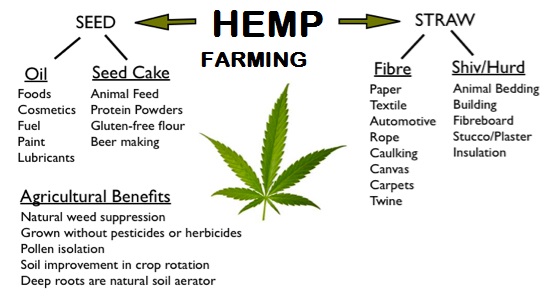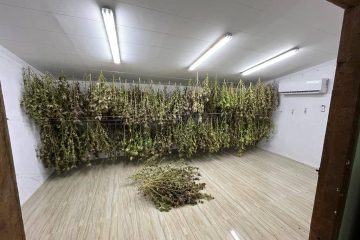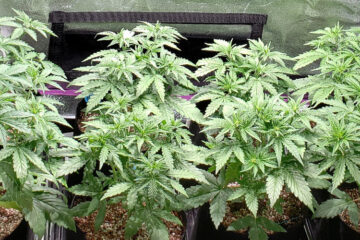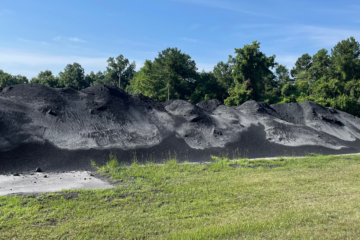For many, hemp is something that is just being discovered as a strong, organic fabric source and health aid. However, humans have actually been spinning hemp into a usable fiber and utilizing its medicinal benefits for thousands of years! The fast-growing, ultra-durable hemp plant is a variety of the cannabis Sativa plant species. You don’t necessarily need to have a farm’s worth of space to harvest hemp at home. Let’s dive into the basics of how to grow hemp?
What To Know About Male And Female Hemp Plants
Hemp plants can either be male or female. Plants typically show pre-flowers that exhibit gender once they reach six weeks. The easiest way to distinguish between male and female hemp plants is to look for Hair Like Pistols that grow on female plants. Look to where the Smaller Stems come out from the Stalk for these “Hairs”
Male plants are preferred when creating hemp fiber due to the fact that they have very firm stalks when they reach maturity. Anyone looking to harvest hemp flowers should focus on growing unfertilized Female plants. Once the Female receives Pollen or becomes “Fertilized”. She will then focus all of her Time and Energy on making the Next Generation of Hemp vs Flowers. This affects your Yield. Also Trichomes will be affected as well.
Photoperiod
Light exposure is a critical factor when growing hemp. The photoperiod refers to the total ratio of light to darkness needed to get a plant to flower. For hemp, an
even split of 12 hours for light and 12 hours for darkness will trigger flowering. This ratio is necessary because Cannabis is what is known as a short-day Plant.
This “Photo-Period” here in Thailand of 12 Hrs Light and 12 Hrs Darkness is why your yields are low and your plants begin Flowing at 8-10 inches High. Adjust your Photo-Periods!!
Indoor Cultivation
Growing hemp indoors requires a carefully controlled and monitored environment that takes into account the air, light, and soil needs of hemp plants. Growers who master the art of creating the right indoor growing environment can enjoy multiple harvests throughout the year. Here’s a checklist of what’s needed when growing hemp indoors:
Auto Flower seeds can be used indoors. Outdoors I recommend Non Photo Seed and you adjust the Photoperiod.
- Airflow is crucial. Using a suction pump and fan to move air between the inside and outside can be helpful. The use of natural air also allows you to control oxygen and humidity levels.
- Manually controlled light levels are essential for cultivation. You must have the ability to completely darken a room for up to 12 hours per day. It’s also important to use artificial light sources/growing lamps indoors.
- Quality, clean, and nutrient-rich soil should be used in growing pots. A pH value of 6.5 is recommended when growing hemp.
Proper growing soil should have a texture that allows it to hold and drain water at appropriate levels for plant nutrition. Hemp requires soil with nutrients like phosphorus, potassium, and nitrogen. It’s also important to make sure plants have large enough growing spaces for proper root stability.
The substrate that you place hemp in needs to be wet without becoming waterlogged. Consistency is highly preferred over a wet-dry cycle. In fact, misting is generally preferred over “watering” your seedlings. A growing area also needs to be covered, protected, and ventilated.
A clean, protected cultivation space is essential for helping plants to thrive without becoming susceptible to parasites, fungus, and other threats.
A Quick Guide To Germinating Hemp Seeds

Why do we pay so much attention to preparing for the seedling stage of hemp? Handling this stage effectively sets your plants up to develop healthy root zones. Ultimately, this determines whether or not your plants will survive, thrive, and produce output.
Germinating hemp seeds is very similar to the seed-starting process for basically every crop and plant. Make sure you’re able to provide an environment with temperatures ranging from 20-21 Celsius before preparing seeds for germination. You’ll also want to get a quality seed-starting soil mix that your seeds can be placed in.
The process of germinating new hemp seeds begins with simply soaking seeds overnight to prime them for optimal germination.
You will see a lot of “Instructional Videos” where paper towels are used and etc.. When the seed “pops” and the little “Tap Root” comes out, it is covered in small Hairs that you may not see. Handling the seeds at this point in time these hairs may become crushed or damaged. This will inhibit the growth and development of your plants. So I recommend starting them immediately after they have been well soaked.
If your Transplanting Use a “Peat Pot” and some B-12 or Transplant solution. Using Peat Pots saves time and also eliminates the Roots from ever being exposed.
Begin the process of placing seeds in your seed-starting soil mixture. Each seed should be placed about 1-3 centimeters deep. This is A factor I have found to be Breed Specific. Not to deep, as your seeds can Rot. It’s recommended that you dome or cover the newly potted seeds to preserve humidity levels. In addition, make sure that the bases of your containers have holes that allow for drainage. You can simply poke some strategic holes if you don’t see any existing ones.
How To Care For New Hemp Seedlings
Temperature Considerations
Thailand is going to be Hot. Hotter than where your seeds likely come from.
Temperature is going to be the most important factor when it comes to seedling success. It’s important to measure and maintain seedling temperature around the clock. Typically, this is done with a simple heat mat. The goal is to keep temperatures between 20 degrees Celsius and 25 degrees Celsius at all times. However, air temperature is just one part of the equation for getting your hemp seedlings to thrive.
Thailand we are typically 28-32 Celsius. A serious Consideration! Learning how to “Harden Off” your seedlings is a must if your going to grow Hemp Flower in Thailand. I start everything Outside.
Let’s break down the other key factors.
Relative Humidity
Relative Humidity refers to the amount of humidity present in the air at any given temperature compared to the highest level possible. For Hemp seedlings, a relative humidity level between 65 percent and 70 percent is optimal. Doming seedlings are the best and easiest way to maintain proper levels of relative humidity.
Lighting Considerations
Fluorescent light is important if you’re trying to create the right environment for germination indoors. That typically means purchasing high-output grow lamps. Lamps need to be positioned directly above your germinating seedlings with a few inches to spare. In Thailand I recommend the use of LED Lighting vs HID. Warmth will bring your seeds up. Using Florescent light does not produce much heat. Using a Heat Mat can be dangerous.
What Happens During the Light Photo-period?
Your seedlings need light virtually around the clock during the photo-period. That means that your Lights need to be on between 18 and 24 hours per day. It’s important to ensure that your growing space has the capacity to safely accommodate this amount of light usage. I have found that the Plants like a bit of Darkness. Remember that Darkness will stimulate the Flowering Cycle.
In Thailand we typically always have a 12-12 Photo-period. Our farms have supplemented Lights throughout. Thus additional Light can be added to increase the Vegetative Growth Stage to increase our Yields.
In addition, be sure to keep bulbs a safe distance from plants to prevent fire hazards. However, it can be helpful to move lighting as close as possible if you notice that your seedlings are stretching. They are looking for Light if they are Long and Thin. A floppy stretched seedling could be a telltale sign that your light is positioned too far away. Generally, grow lights should be used with timer settings to ensure consistent light exposure.
What Do You Feed Hemp Seedlings? I make my own Living Soil. This Soil contains all the Plant needs. Seedling nutrition is essential for getting the output. A big part of Hemp nutrition is fertilizer. However, timing is everything when it comes to properly feed your hemp seedlings. Immature hemp that still has minimal root development is at risk of being over-fertilized and over-watered.
The right balance can often be achieved by supplying nutrients at half or quarter strengths. What is the specific feed you should use with Hemp? Generally, you’re looking for a fertilizer with a ratio of nitrogen (N), phosphorus (P), and potassium (K) that works out to be 3:1:2 for the early stages of growth.
Transplanting Your Hemp Seedlings
Transplanting if not done correctly can kill your Plants. Also transplantation usually does cause a few days of growth loss. I use “Peat Pots” or Paper Pots. These can be put into the new Grow Pots without touching and or exposing the Plants’ roots to the Air, or any sort of shock..i.e. new growth medium example.
Your seedlings will eventually be mature enough to be transplanted! How will you know? A telltale sign that it’s time to move your Hemp is that you’re noting that your seedlings have rooted to the bottoms or sides of the cells you have them contained in. It’s important to use a high-quality soil/transplant mix to assist with root boosting. Or make your own Grow Medium. If you need some help with this let me know.
Here’s a rundown of some tips for your first transplant:
- Make sure all of the soil you’re working with is dry to ensure that soil doesn’t “fall apart” during transplanting.
- You’ll want to slide the plant into the larger pot using a roots-first maneuver.
- Always replace the topsoil that was lost during the transition.
- Use water to “seal” it all together as the last step. I “Gently” Tap the Containers while full of water to assist in the settling of soil around the roots. This excess water drains out the bottom as there is a drain hole. Very Important.
- If you are going to do a lot of Transplanting I recommend the use of a Transplant Solution. Seaweed Solution and B-12 work very well.
Your first transplant is really just a transitional step. You’ll be waiting for the growing plants to make roots at the bottoms and sides of the larger pots before you’ll make the final transplant. Generally, you’ll want to use a much larger container or specialized final grow bag for this step. You’ll also be swapping from a transplant mix to a potting mix with a compost base. It is best to not transplant to much. Starting off with the same Soil throughout is the best way to go.
Some Special Tips for Growing Flowering Hemp Plants

The Rules for Growing Flowering Hemp Plants
The rules change a bit once you’re dealing with flowering Hemp plants. Mature flowering plants do need temperatures between 20 degrees Celsius and 25 degrees Celsius. Relative humidity should generally fall in the range between 40 percent and 50 percent. You’ll also find that maintaining proper air circulation within your growing space is hugely important for supporting healthy cultivation.
Allowing the air to go stagnant within your growing space exposes your plants to risks from pest infestations and fungal diseases. I use commercial Fans. Moving the Air around quite a bit assist the Plants in Plant Transpiration and Mold Spores look for dampness. (Plant Transpiration)
Proper venting is essential if your growing area is tented or covered in some way. Many growers find that oscillating fans are effective at keeping air moving just enough to avoid some of the common threats for plants in enclosed growing spaces. Flowering plants can be shifted to split-day light exposure.
That means dividing light and dark into 12-hour periods. A timed grow lamp is often the best method for ensuring consistency. Flowering plants do need consistent watering. A Plant that is 3-4 Meters in Height will likely need watering every day. However, the goal is to prevent them from drying out without necessarily saturating them in water.
Feeding rituals should also be adjusted accordingly for flowering hemp.
- Your nitrogen (N)
- phosphorus (P)
- potassium (K) ratio is going to be adjusted from 3:1:2 to 1:3:4.
A Little Crash Course in Hemp Harvesting
How Do You, Harvest Hemp?
You can either harvest Hemp seed or Hemp fiber. Both present their own advantages and challenges. In addition, specialty tools and storage operations must be in place to ensure that you aren’t doing the difficult work of growing Hemp that will be destroyed due to things like harvesting when plants are still too immature, allowing the fungus to grow or compromising stalk integrity.
The Way to Harvest Hemp Fiber
Hemp fiber is generally ready to be harvested once you notice that the Male plant has finished pollen production. Generally, the big telltale sign is that the first seeds are developing. It’s important to act at this point because allowing the fiber to mature beyond this stage could simply leave it too coarse to be valuable. Of course, the exception is when you’re intentionally harvesting fiber from male plants that can be used to create coarser, denser products.
The denser fiber harvested from male Hemp plants dies shortly after pollination is complete. Keep in mind that there’s no need to chop or break stems during harvesting. Tall, intact fibers are the most desirable.
The Way to Harvest Hemp Seeds
You should go into seed harvesting with the knowledge that this is a very difficult endeavor. What many first-time harvesters don’t realize is that hemp seeds on neighboring plants actually mature at varying and sporadic rates. You may even witness seeds on the same plant maturing at different rates.
You’re big aim when seed harvesting is really just to avoid as much seed loss as possible. The actual process of manually harvesting is also pretty delicate. Hemp must be gathered and cleaned. All stalks, leaves, and immature seeds must be cleared to leave behind just usable, mature hemp seed. It’s also important to have a cool, dry area with grain bins where you can safely store your hemp seeds until the next stage of processing.
Frequently Asked Questions
What Is the Ideal Soil Temperature for Planting Hemp Seeds?
A soil temperature that hovers around 50 degrees Fahrenheit is considered ideal. This is a current issue for all of us here in Thailand. Seeds or Genetics from a “Non Thailand” climate do not do well outdoors here. You will see all successful CBD Flower grows in Thailand being done indoors.
How Much Sun Will Hemp Seeds Need?
Six to eight hours of full/direct sunlight after planting.
What’s the Best Time of Year to Plant Hemp Seeds?
Generally, planting season is from April through June. Being able to have appropriate soil temperature and sun levels will be more important than what the calendar says. However here in Thailand one can Plant all year round. Now if you do not have a constant, Reliable water source then wait until you see all the Thai People starting their Rice Fields. Thailand has a very predictable rainy Season.
How Many Days Until Hemp Seeds Emerge?
You can expect to see germination beginning anywhere from two to five days after you plant seeds.
What Is Proper Depth When Planting Hemp Seeds?
Moisture levels determine proper seed depth. Depths ranging from 0.2 to 0.5 are appropriate in environments where moisture is ample. Seeds planted in drier conditions can require a depth of up to 1.5 inches. One needs some experience in Growing as if you put the seed too deep it can “rot” and will not emerge.
What Is the Spacing Requirement for Hemp Rows?
Many varieties need just six to seven inches of space. Others need as much as 25 inches apart. This depends a lot upon if one is Growing for CBD Containing Flower or Grain.
How Soon Do Hemp Plants Reach Maturity?
It takes between 60 and 90 days for hemp plants to fully mature. Strain Dependent.


